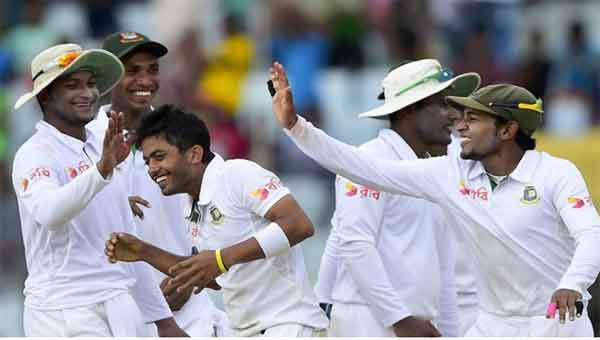
Colombo, Sri Lanka (BBN) – From being brave in selecting their XI to holding more catches, Bangladesh did several things better in Colombo than in other Test outings this season.
IMPROVED IN-THE-MOMENT APPLICATION
Mehedi Hasan made two telling contributions to Bangladesh's effort in the Colombo Test, reports ESPNcricinfo.
His superb offbreak bowling removed Upul Tharanga and gave Bangladesh an important breakthrough on the fourth day.
But it was on the fifth day when his presence of mind made an even bigger difference: Dilruwan Perera was becoming a hard proposition.
When he had a misunderstanding with Suranga Lakmal, Subashis Roy threw poorly to the bowler's end, where Mehedi collected the wide throw brilliantly and broke the stumps.
It is worth remembering that this is the same Mehedi who couldn't collect a similarly tricky throw when M Vijay was batting on 35 in the Hyderabad Test a month ago.
Kamrul Islam Rabbi had made a fine stop at short square leg and threw towards the bowler Miraz who couldn't break the stumps in time.
Vijay went on to score 108 and India went on to post a massive 600-plus total, but here, Dilruwan's wicket got them a much-needed breakthrough at a time when the Test was slipping out of Bangladesh's grasp.
Better application during the most recent Test match made all the difference, though.
THE SAFER CORDON
Bangladesh dropped a total of 20 catches during their tour to New Zealand, and there were mistakes in Hyderabad too.
So when Soumya Sarkar took four catches at slip in Colombo, it was a big step up for the Bangladesh slip cordon.
Soumya has yet to nail down his place in the Test team with his primary skill, but promises much with his fielding abilities.
He is safe in the outfield too, as he showed in last year's World T20, pulling off two stunning catches on the boundary.
His slip-catching technique is quite simple. He appears to have plenty of time setting himself up for a catch, never looking hurried.
Their coach Chandika Hathurusingha had once said that it was Soumya's catching that made him stand out, because it suggested he would also have a lot of time playing fast bowling.
Similarly, Bangladesh should also be encouraged seeing Liton Das and Mushfiqur Rahim display great anticipation to take catches off Niroshan Dickwella.
While it is no secret that Dickwella has a predilection to play the sweep and reverse sweep, these are catches Bangladesh wicketkeepers haven't often been seen taking previously.
Not long ago, Mushfiqur's missed stumping against Wriddhiman Saha in Hyderabad gave the India wicketkeeper a chance to reach his second Test century.
Following that, for the second time in three years, the team management asked Mushfiqur to give up the gloves and hand them over to Liton.
After he recovers from a chest injury, Liton is expected to resume duties behind the stumps in Tests.
BALANCE BETWEEN AGGRESSION AND PRAGMATISM
Bangladesh batsmen have seemed unnecessarily hurried at different times in all five Tests this season.
But in phases during this Test, they showed restraint that seemed to have been missing in earlier games.
Shakib Al Hasan, in particular, played with great patience on the third day, mixing an attacking game with regular singles to keep up pressure on the opponents.
The approach served him well in Colombo, and the allrounder ended up with 116 runs in the Test.
He had played a similar innings in Wellington, which fetched him 217 runs.
It is an approach worth honing, as attacking too much too soon - like he did in Christchurch - can be an unsustainable Test strategy.
BRAVE SELECTION
Bangladesh made four changes to the XI that played in Galle. Liton Das's injury got Sabbir Rahman into the team but the other three were tactical changes.
Imrul Kayes, Taijul Islam and Mosaddek Hossain took the places of Mominul Haque, Taskin Ahmed and Mahmudullah.
The replacements didn't set the world alight but neither were those that were dropped missed.
Mahmudullah was in woeful form while Mominul looked to be short of ideas against offspin.
Subashis was picked ahead of Taskin, perhaps because the former displayed better control with the ball in Galle.
Taijul, who ultimately took the place of Taskin in the XI, provided the bowling attack with his efficiency in cutting down runs, even if he did not pick up as many wickets as Bangladesh might have hoped.
Mosaddek replacing Mahmudullah paid off as he struck an important 75 in the first innings, and looked nerveless under pressure in the second innings.
Imrul did not contribute the runs he was brought in to score, but picking him meant that Soumya Sarkar would feel the pinch of competition despite scoring three fifties.
One must commend those who picked the team too, as they showed courage to drop a senior figure in the Bangladesh dressing room.
They also dared to drop Mominul and gave an aggressive batsman like Sabbir the No. 4 spot.
Scoring runs is important now in the Bangladesh line-up, and this means every batsman is likely to be on their toes.
ADAPTATION TO THE UNFAMILIAR
The Bangladesh batsmen have often been troubled by bowlers with slightly different actions or someone offering something different - like Lakshan Sandakan's chinaman action.
In the Hyderabad practice match, a similar bowler in Kuldeep Yadav troubled them. In the Galle Test, they reportedly had trouble picking Sandakan out of the hand.
This game, they kept picking Sandakan off the pitch.
It gave them less time to react to his deliveries, and he had Shakib Al Hasan and Mushfiqur Rahim caught down the leg side.
But they appeared to understand better how to play the Sri Lankan bowler, and although he took four wickets in the first innings, he was rendered ineffective in the second - Tamim even deposited him for a big six over long-on at one stage.
BBN/MS/SK